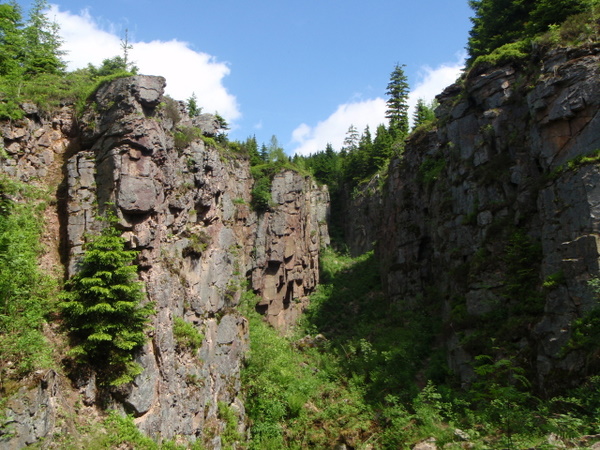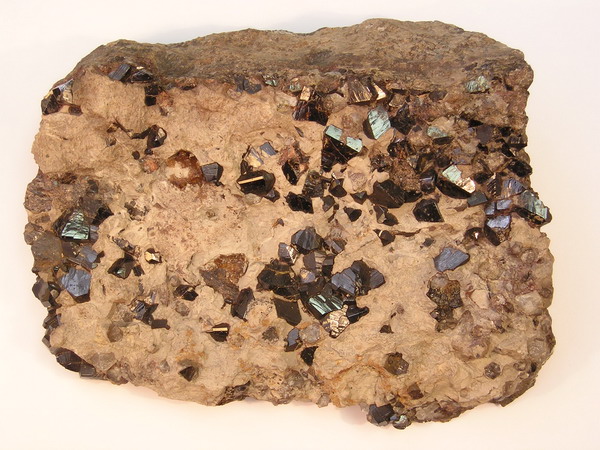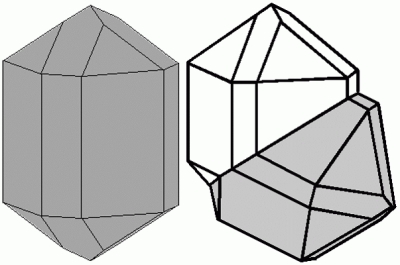

Cín (chem. Sn) je mekký kov vyskytující se ve ctyrech alotropních modifikacích. Nejcastejší jsou šedá (α, krychlová soustava) a bílá (β, ctverecná soustava). Cín má široké využití, a to predevším ve slitinách (pájky, ložiskový kov, bronz...). Dále se používá v potravinárství (pro uchovávání potravin - konzervy...). V minulosti se pak využíval k výrobe užitkových nádob a umeleckých predmetu. Více viz wikipedia.
Cín se vyrábí prevážne z cínovce. Cínovec (kasiterit), chemicky oxid cinicitý (SnO2), je tvrdý minerál krystalizující ve ctverecné soustave. Dipyramidální krystaly bývají casto zdvojcatelé. Jeho barva bývá hnedocerná, šedá ci žlutá. Více viz wikipedia.

Již ve 14. století se v oblasti Horní Blatné cín rýžoval z náplavu podél potoku. Probíhalo také získávání ze sute na zvetralých výchozech žil. Koncem 15. století zacaly vznikat doly. Težba zacínala tam, kde ložiska vystupovala na povrch, a dále postupovala zahlubováním. Stropy a steny nekterých takto vyrubaných podzemních komor a chodeb se však pozdeji zrítily, címž vznikly propadliny. Ke dvema z nich vás zavede tato Earthcache.
Ledová jáma vznikla propadem dolu Jirí a díky kamenum uvolneným ze sten je dnes cástecne zasypaná. Jáma je velmi úzká a hluboká až 15-20m (samotný dul dosahoval dle historických pramenu hloubky až 50m). Profil této prurvy zpusobuje jen minimální obeh vzduchu, díky cemuž zde lze spatrit i v letních mesících jeskynní led.
Vlcí jáma vdecí pak za své jméno bývalému dolu Wolfgang, na jehož míste tato nejvetší propadlina oblasti (zhruba 120m dlouhá, 14m široká a 25m hluboká) vznikla. Dnes je zde možné videt zbytky puvodních dulních komor a chodeb.
K odlovení této Earthcache velmi doporucujeme projít si celou naucnou stezku Vlcí jámy (délka necelých 5km). Informace na cedulích (vcetne ceduli geoparku v Horni Blatne a u rozhledny) vám mohou pomoci odpovedet na naše otázky. Jednou ze zastávek je i rozhledna na Blatenském vrchu, poblíž které mužete odlovit cache GCPQKB. Poslední zastávkou stezky je muzeum cínu v Horní Blatné. Jeho otvírací doba je ponekud komplikovanejší, ale pokud je zavreno, mužete zkusit zazvonit. K odlovu keše není jeho návšteva nutná.
Podmínky odlovu:
1. K cemu sloužil Blatenský príkop?
2. Jaké další kovy ci rudy se v oblasti krome cínovce ješte težily?
3. Jakou horninou je tvoren Blatenský vrch?
4. (dle nových pravidel nepovinná, ale doporucena, pokud máte možnost) Do logu priložte foto z Vlcí jámy (úvodní souradnice) a (pokud to není nebezpecné) z Ledové jámy (waypoint), viz spoiler.
Odpovedi na první 3 otázky nám zasílejte pomocí e-mailu v profilu. Logovat mužete následne ihned, pokud neco nebude v porádku, kontaktujeme vás.

Tin (chem. symbol Sn) is a soft metal with four possible allotropes. The most common are gray (α, cubic crystal structure) and white (β, tetragonal) allotropes. Tin is widely used, especially in alloys (solders, babbit metal, bronze...). It is also used for food industry (for food preservation - tins...). In the past, various tableware and works of art were made of tin. For more information, please see Wikipedia
Tin is obtained mainly from cassiterite. Cassiterite (tin dioxide, SnO2),), is a hard mineral with tetragonal crystal structure. Its dipyramidal crystals are often twinned. The color is usually brownish black, gray or yellow. Wikipedia

In the Horní Blatná region, tin grains had been extracted by panning from creek alluvia since the 14th century. Cassiterite had been also extracted from weathered and sandy outcrops of cassiterite veins. Mines had been founded since the end of the 15th century. The mining began at the places where the veins surfaced, and continued by digging deeper. However, the ceilings and walls of some of these mining excavations later caved in, resulting in depressions. Two of these depressions are the goal of this Earthcache.
Ledová jáma (Ice pit) was created by the collapsing Jirí (George) mine and today it is partially filled up by rocks dislodged from the walls. The pit is very narrow and 15-20m deep (the mine itself had been up to 50m deep according to the available historical sources). The gap’s profile results in a minimal air circulation, which is responsible for the chance to see bottom ice even in the summer months.
Vlcí jáma (Wolf pit) is named after the former Wolfgang mine, on whose grounds the biggest depression of the area (approximately 120m long, 14m wide and 25m deep) lies. Today it is possible to see the remains of the original rooms and galleries.
We highly recommend taking the whole Vlcí jámy nature trail (approx. 5km / 3mi long) to complete this Earthcache. The information signs can help you answer our questions (all signs include German, the geopark signs in Horní Blatná and Blatná hill lookout also English). The trail also includes the lookout on the Blatná hill, with a nearby cache GCPQKB. The last stop of the trail is the Tin Museum in Horní Blatná. Its opening hours are a bit complicated, but you may try ring the bell when it’s closed. It is however not mandatory for the cache logging.
Log requirements:
1. What was the purpose of the Blatná water channel ("Blatenský príkop" / Erbwassergraben)? (you may guess, if you don’t understand Czech or German)
2. Which other metals or ores were mined in this area except cassiterite?
3. Which rock is the Blatná hill made of?
4. (optional according to the new rules, but recommended if you have the equipment) Include photos from the Wolf pit (Initial coordinates) and (if the conditions are not dangerous) the Ice pit (waypoint - see the spoilers) to your log.
Send the answers to the first three questions by e-mail in our profile. You may then log immediately - we will contact you if some answers are incorrect.